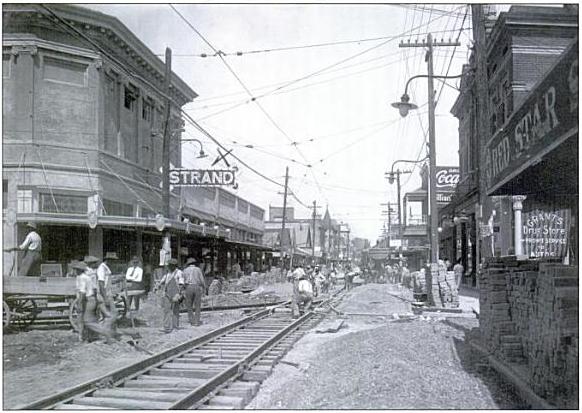
BILOXI CITY RAILWAY COMPANY
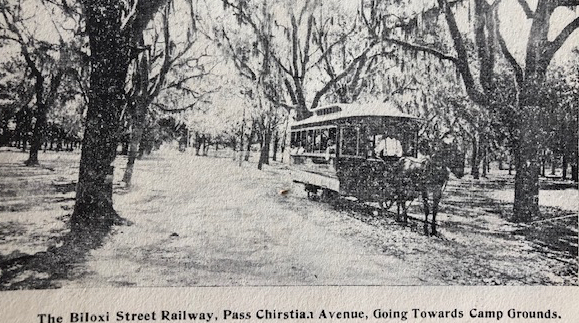
1895
The Biloxi City Railway Company was established in March 1895 by Dr. J.J. Lemon, president; J.C. Bradford, vice-pres.; Edward G. Burklin, general mgr. and superintendent; Col. EdwardW. Morrill [1939-1910], sec.-treas.; and W.H. Maybin, gen. attorney. Laying of track was to commence shortly as cars, rails, ties, etc. had been acquired. $8000 worth of company stock had been sold at $25 per share. Edward G. Burklin (1860-1931) had gone to NOLA and acquired at a heavy discount 15 rail cars, six miles of track, turn-tables, switches, and curves from the Prytania, Rampart, Dauphine Lines. The Biloxi City Railway ran from the L&N Depot south to Howard Avenue and east to Main Street. From Main Street south to the Beach and then to Point Cadet.(The Biloxi Herald, March 16, 1895, p. 8 and March 30, 30, 1895, p. 8)
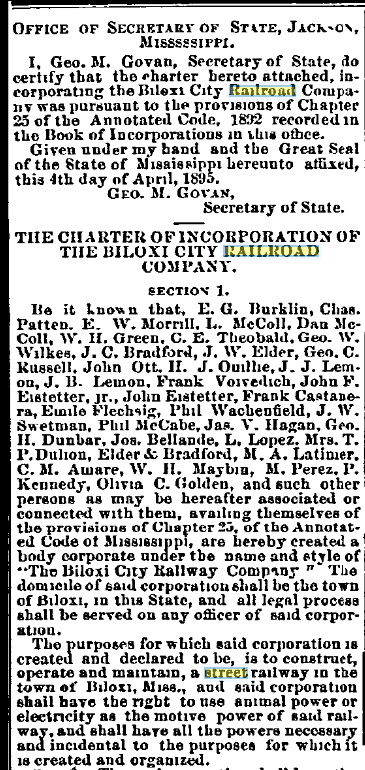
[The Biloxi Herald, April 20, 1895. p. 8]
Biloxi Electric Power Company
Biloxi became ‘electrified’ with the formation of the Biloxi Electric Power Company in 1894. It was chartered in the State of Mississippi on February 3, 1894 by a large contingent of Biloxi merchants, Coast seafood packers, and other prominent businessmen. Among them were: Edward G. Burklin (1860-1920+), Ed Glennan (1854-1933), J.W. Swetman (1863-1937), J.J. Lemon (1825-1915), E.J. Buck, Lazaro Lopez (1850-1903), Walter A. White (1854-1942), Harry T. Howard (1856-1930), Charles F. Theobald (1839-1903), John C. Bradford (1855-1928), Sherwood Bradford (1857-1937), Lyman Bradford (1863-1944), George E. Theobald (1873-1921), Francis B. Dunbar (1846-1908), George H. Dunbar (1844-1917), W.T. Bolton (1859-1923), S.B. Mayers, Frank Voivedich (1860-1930), John Eistetter, Isidore Heidenheim, Manuel Perez, John Bousquet (18-1908), Vincent Voivedich (1850-1927), Charles Patton (1839-1922), Casimir Harvey (1846-1905), John Johnson, Peter Eskald (1856-1944), T.A. Cleary, T.B. Cleary, C.M. Amare, Frank T. Howard (1855-1911), Nicholas Voivedich (1850-1937), J.W. Elder, Charles Redding, A. Bousquet, Lizzie Bradford, and W.K.M. Dukate (1852-1916). The first Board of Directors of the Biloxi Electric Power Company was composed of the following: Edward G. Burklin, Ed Glennan, J.J. Lemon, Lazaro Lopez, J.W. Swetman, E.J. Buck, and Walter A. White.(Harrison Co., Mississippi Chattel Deed Bk. 2, p. 116)
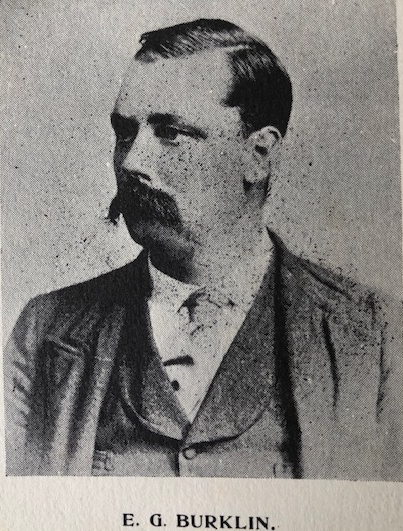
Edward G. Burklin
Edward G. Burklin (1860-1931) was born at Vandalia, Missouri. He came to Biloxi in the fall of 1892 with the purpose of building a flour mill and an electric light plant near the L&N Depot. He had erected several flour mills in Missouri. Mr. Burklin returned to Missouri and expired at Carthage, Jasper County, Missouri on June 3, 1931. At Biloxi, Mr. Burklin founded the light and power plant, first street railway [horse drawn], and telephone system.(The Biloxi Herald, November 5, 1892, p. 4)
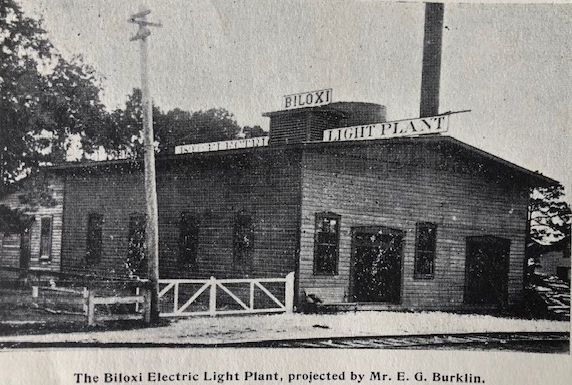
[from Along The Gulf, Dye, 1895]
In April 1893, the Biloxi Milling Company, commenced operations making flour and meal. It was founded by Missourians, Edward G. Burklin (1860-1931), James B. 'Buck' Chinn (1857-1912), R.D. Chinn, and Mr. Brewton. The mill was situated on the northeast corner of Magnolia Street immediately north of the L&N Railroad tracks.(The Biloxi Herald, January 7, 1893, p. 8 and April 22, 1893, p. 1)
1902
Incorporation
The Biloxi Electric Street Railway and Power Company was chartered in the State of Mississippi on
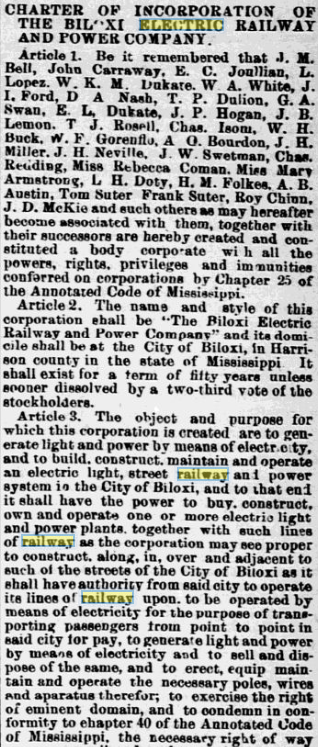
[The Biloxi Herald, December 6, 1902, p. 3]
The City of Biloxi gave the Biloxi Electric Railroad and Power Company led by W.K.M. Dukate the right to build a railway on Reynoir Street from the L&N RR to Howard Avenue and from Howard Avenue east to Main Street. This privilege had been granted to E.C. Jouillian (1864-1931) in August 1902.(Harrison Co., Ms. Land Deed Bk. 67, p. 247)
1903
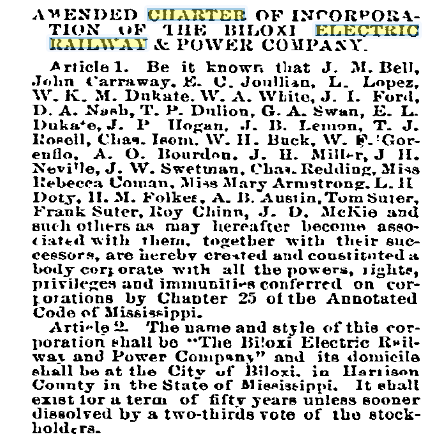
[The Biloxi Daily Herald, March 14, 1903, p. 8]
In early July, the Biloxi Electric Street Railway and Power Company contracted to acquire 300,000 bricks from the Biloxi Brick Company to erect their power house on Lameuse Street. The brick company agreed to deliver 75,000 brick immediately with the remainder to arrive within thirty days. The bricks cost $8 per one thousand. It was anticipated that the power house construction would start in ten days. Also at this time, six miles of trolley wire and the large steam domes of the big boilers arrived.(The Biloxi Daily Herald, July 3, 1903, p. 6)
The City of Biloxi signed a new eighteen month contract with the Biloxi Electric Street Railway to furnish free city lights.(The Biloxi Daily Herald, July 8, 1903, p. 5)
Two more car loads of boiler fixtures for the power plant have arrived.(The Biloxi Daily Herald, July 8, 1903, p. 5)
The Biloxi Electric Power Company was acquired by the Biloxi Electric Street Railway Power Company. The transaction was enacted for $29,500 in cash and $18,000 in stock.(The Biloxi Herald, Novemebr 4, 1903, p.6)
By early September crews were working feverishly on Point Cadet in east Biloxi. Track was being laid on Oak Street from East Howard Avenue to the beach and grading was almost completed from Oak Street east to the Barataria Canning Company. Archille Chiapella (1862-1936) who resided on the east side of Reynoir Street between Howard Avenue and the L&N Railroad was demanding the Biloxi Electric Street Railway Company place their tracks in the center of the street when it fronted his property. Chiapella’s request was redundant as the company preferred to locate their tracks in the street’s center. In addition, the street railway company had no control of where the tracks were placed on the street as the alderman of each ward in the city had this power.(The Biloxi Daily Herald, September 3, 1903, p. 6)
The stock holders of the Biloxi Electric Light Company sued the directors of the company for $4166.67, the pro rata, due to the holders of 25 shares of stock, from the Biloxi Electric Street Railway Power Company.(The Biloxi Daily Herald, September 4, 1903, p. 6)
The fountain situated at Lameuse Street and Howard Avenue had to be relocated to Lameuse Street and Front Street in order that the electric railway could pass unimpeded. Martin Hass, the City Plumber, was in charge of the project. Following the large conflagration of 1889, Harry T. Howard (1856-1930), philanthropist, donated an artesian well and fountain to the City at this location to provide a ready source of water for drinking and fire purposes.(The Biloxi Daily Herald, September 9, 1903, p. 6)
October 1903
The work of grading Lameuse Street for the electric railroad from Howard Avenue from the Montross Hotel was commenced on October 13, 1903. Contractor O’Beirne is building the transportation route.(The Biloxi Daily Herald, October 13, 1903, p. 8 and October 19, 1903, p. 8)
Route
The Biloxi Electric Street Railway ran from the western corporate limits of Biloxi on Front Street, now West Beach Boulevard, to Porter Avenue. Here the tracks turned north onto Porter and went to Howard Avenue where the line ran east along Howard Avenue to Oak Street. The railway went south on Oak Street to Front Street and then east on Front Street to Cadet Street, near the Barataria Canning Company. A spur also ran north from Howard Avenue on Oak Street to the L&N Railroad. Another short route from Howard Avenue connected the Biloxi Electric Street Railway with Front Street from Lameuse Street. The Back Bay section of Biloxi was reached by the line from Howard Avenue and Reynoir going north to Back Bay and then east to the factory of E.C. Joullian, which was on Back Bay near Main Street.(Harrison Co., Mississippi Land Deed Bk. 104, pp. 104-105)

Gulfport and Mississippi Coast Traction Company-1905
The Biloxi Electric Street Railway & Power Company was acquired by Joseph T. Jones and the Gulfport and Mississippi Coast Traction Company for $1 million on 15 September 1905. The conveyance included the following: the Biloxi street railway and franchise; Biloxi electric street contract; electirc plant at Biloxi and Ocean Springs; and desire to extned the railway to Gulfport and beyond.(The Biloxi Herald, July 7, 1905, p. 1 and Harrison Co., Mississippi Land Deed Bk. 70, p. 109)
1924
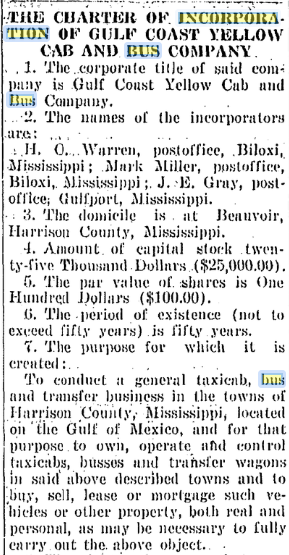
[The Daily Herald, June 12, 1924, p. 2]
Mississippi Power Company-1924
The Mississippi Power Company was organized when it acquired the Gulfport and Mississippi Coast Traction Company on December 31, 1924. J.M. Barry, president and Frank N. Savage, assistant secretary. [also reported ] The Gulfport and Mississippi Coast Traction Company was acquired by the Mississippi Power Company in late December.(Harrison County, Mississippi Land Deed Bk. 151, p. 340 and The Daily Herald, December 29, 1924, p. 1)
1926
In early January, Barney E. Eaton [1878-1944] of the Mississippi Power Company related that street car service between Gulfport and Long Beach had been replaced by motor coaches and that the company had invested about $200,000 in buses and ancillary equipment.[The Daily Herald, January 2, 1926, p. 1]
In March 1926, the Mississippi Power Company announced that a hydro-electric line paralleling the Coast would be included in its $70 million development plan. The companies hydro-electric plants were situated on the Coosa and Tallapoosa Rivers in Alabama and a 110,000 volt line would be built from the Alabama-Mississippi state line to a step-down transformer station at Gulfport. Permission had been granted to the company to construct power lines on the bridge across the Back Bay of Biloxi from D’Iberville.(The Biloxi News, March 28, 1926, p. 1)
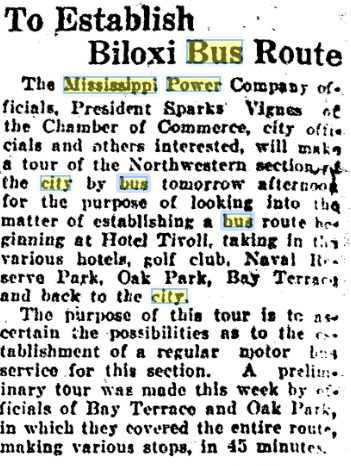
[The Daily Herald, December 1, 1926, p. 2]
1927
John Donzelli [1888-1950], native of Sicily, and spouse Mabel Roberts [1900-1982], born in Wisconsin, operated the Golden Fawn Bus Line for several years at Gulfport. They were victims of the Depression and lost their Gulfport home and in 1929 relocated to Indianapolis where John cleaned busses for Greyhound. Lucy,a daughter, was born at Gulfport in August 1927.
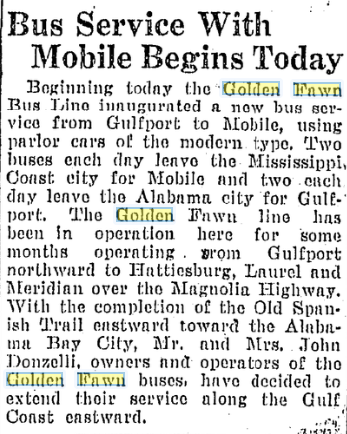
[The Daily Herald, April 12, 1927, p. 3]
The Teche Transfer Company was given the priviledge of transporting passengers by bus from New Orleans to the Coast with stops at Bay St. Louis, Pass Christian and Biloxi. Teche was not permitted to pick up local passengers, which were provided transportation by the City Bus Company between Pass Christian and Biloxi.[The Daily Herald, October 13, 1927, p. 7]
1932
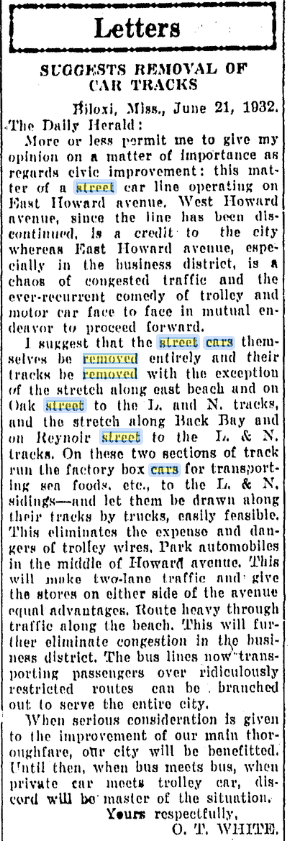
[The Daily Herald, June 22, 1932, p. 8]

[The Daily Herald, September 26, 1932, p. 1]
1936
The ICC reported in October 1936, Gulfport and Mississippi Coast Traction Company had accrued a deficit of $366,688. Total investment in the road and equipment was $390, 686.(The Daily Herald, October 1, 1936, p. 1)
1944
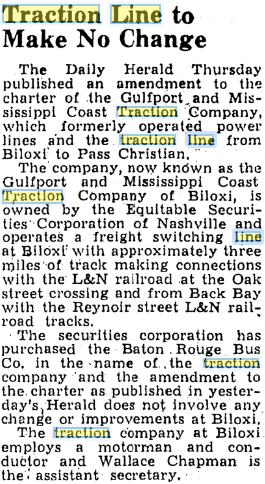
[The Daily Herald, December 13, 1944]
1949
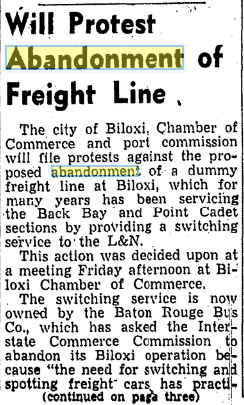

[The Daily Herald, January 15, 1949, p. 1]

[The Daily Herald, June 8, 1949, p. 9]

[The Daily Herald, August 30, 1949, p. 1]


[The Daily Herald, August 30, 1949, p. 1]
REFERENCES:
The Biloxi Herald, “Electric Lights”, November 5, 1892.
The Biloxi Herald, “Local Happenings”, January 7, 1893, p. 8
The Biloxi Herald, “Local Happenings”, April 22, 1893, p. 1
The Biloxi Herald, “Lights for the town”, September 30, 1893.
The Biloxi Herald, “Progressive Biloxi”, March 16, 1895.
The Biloxi Herald, “The City Railroad”, March 30, 1895.
The Biloxi Herald, “Charter of Incorporation of the Biloxi City Railroad Company”, April 20, 1895.
The Biloxi Daily Herald, “Stock taken”, November 15, 1902.
TThe Biloxi Daily Herald, “The Charter”, December 18, 1902.
The Biloxi Daily Herald, “Electric Street Railway”, January 16, 1903.
The Biloxi Daily Herald, “Biloxi Electric Railway Company”, February 24, 1903.
The Biloxi Daily Herald, “Damage suit”, June 17, 1903.
The Biloxi Daily Herald, “Big Brick deal”, July 3, 1903.
The Biloxi Daily Herald, “Biloxi for Biloxians”, July 3, 1903.
The Biloxi Daily Herald, “Biloxi for Biloxians”, July 6, 1903.
The Biloxi Daily Herald, “City Fathers”, July 8, 1903.
The Biloxi Daily Herald, “Biloxi for Biloxians”, July 9, 1903.
The Biloxi Daily Herald, “The silver spike”, August 13, 1903.
The Biloxi Daily Herald, “City News”, September 3, 1903.
The Biloxi Daily Herald, “Want a receiver”, September 4, 1903.
The Biloxi Daily Herald, “Fountain to be moved”, September 9, 1903.
The Biloxi Daily Herald, “City Items”, October 13, 1903.
The Biloxi Daily Herald, “City Items”, October 19, 1903.
The Biloxi Daily Herald, “Deal closed”, November 4, 1903
The Biloxi Daily Herald, “Let us have an electric line to Biloxi”, November 25, 1903.
The Biloxi Daily Herald, “The cars”, December 15, 1903.
The Biloxi Daily Herald, “Money makers”, March 25, 1904.
The Biloxi Daily Herald, “Work on Coast railway to begin”, July 4, 1905.
The Biloxi Daily Herald, “Electric plant sold to Jones" July 7, 1905.
The Daily Herald, “Biloxi promoter [E.G. Burklin] of 1893 writes”, October 4, 1919.
The Daily Herald, “Eaton makes statement”, January 2, 1926.
The Daily Herald, “Tech [sic] Bus Line will not take up Coast passengers”, October 13, 1927.
The Daily News, “Power line to Coast included in companies program”, March 28, 1926.
- Printer-friendly version
- 1576 views